Patient Access to Expensive Treatment: A Global Health Perspective
VerifiedAdded on 2021/06/17
|6
|1687
|65
Essay
AI Summary
This essay critically examines the global issue of patient access to prohibitively expensive treatments, focusing on the Australian context. It highlights the challenges posed by the high cost of new drugs, particularly for cancer patients and economically marginalized communities. The essay discusses the principles of the Common Good and Catholic Social Teaching, emphasizing the importance of affordable healthcare as a fundamental right. It analyzes the role of the Pharmaceutical Benefits Scheme (PBS) in Australia, its limitations, and potential solutions such as government subsidies, tax rebates, and community-based initiatives. The essay suggests recommendations including pressure on the government, involvement of religious groups and NGOs, and longitudinal research to assess the impact of subsidized medicines. It also proposes collaboration with hospitals and healthcare organizations to distribute expensive medicines at reasonable costs, advocating for a people-centered public health system. The essay draws on references from various sources to support its arguments.
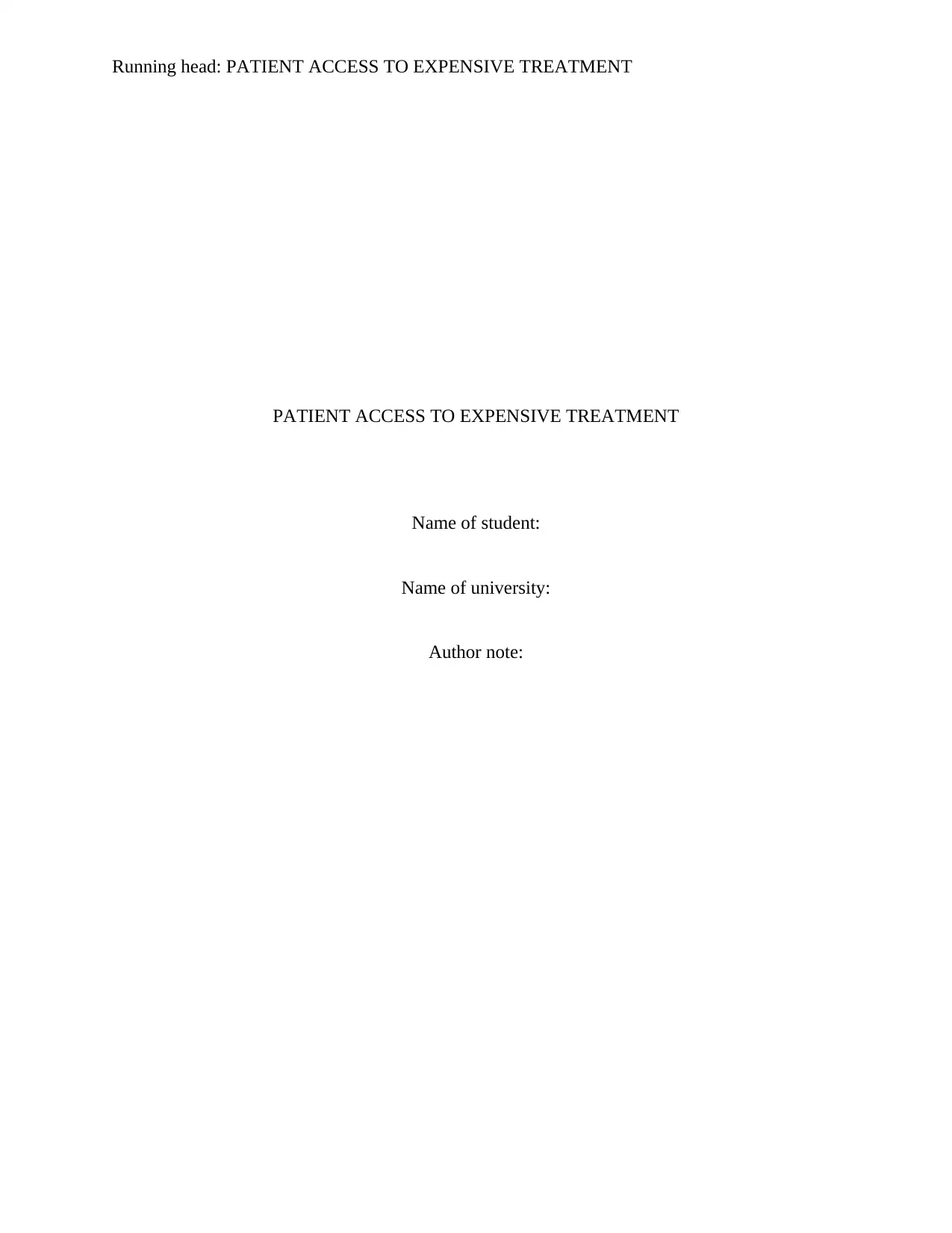
Running head: PATIENT ACCESS TO EXPENSIVE TREATMENT
PATIENT ACCESS TO EXPENSIVE TREATMENT
Name of student:
Name of university:
Author note:
PATIENT ACCESS TO EXPENSIVE TREATMENT
Name of student:
Name of university:
Author note:
Paraphrase This Document
Need a fresh take? Get an instant paraphrase of this document with our AI Paraphraser
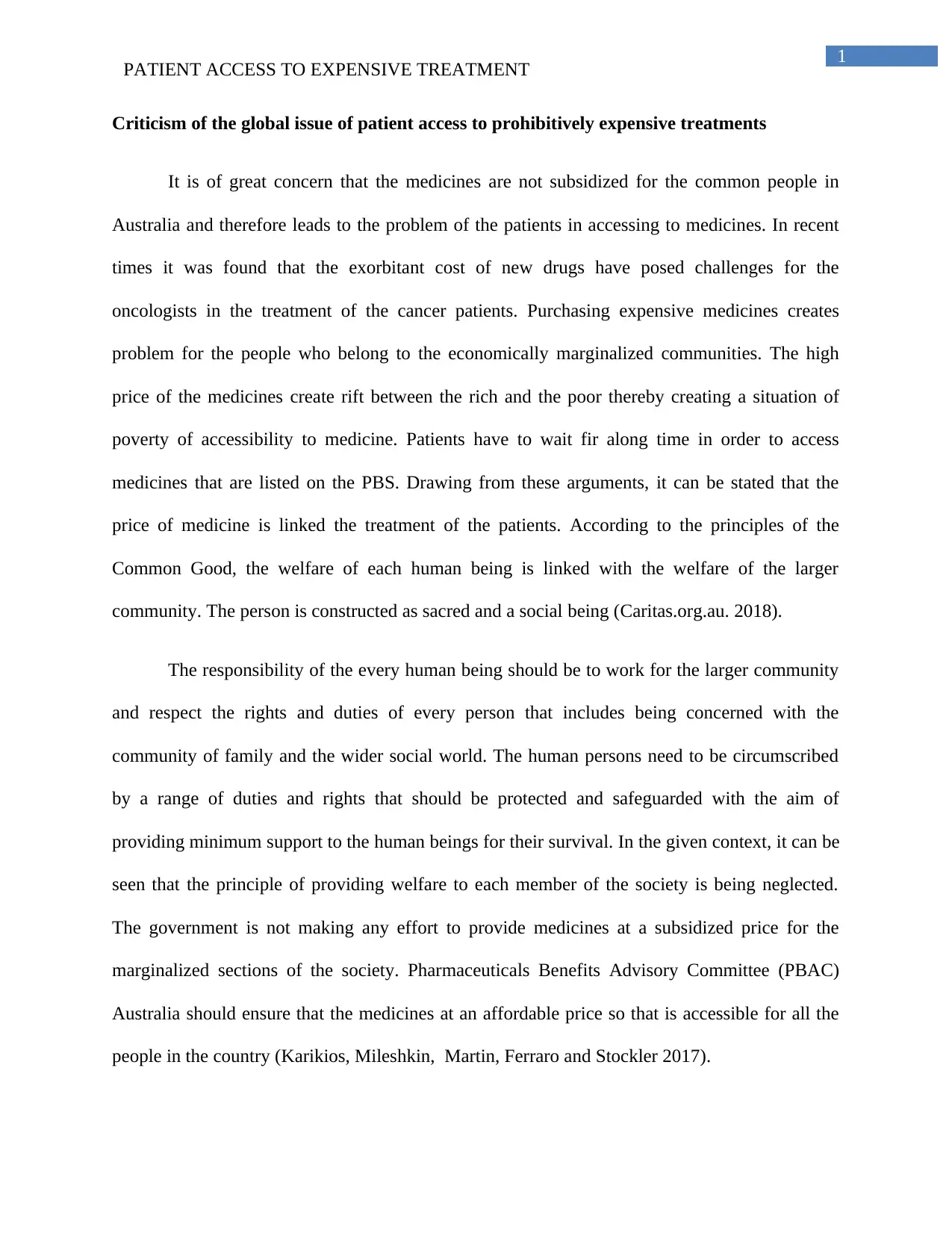
1
PATIENT ACCESS TO EXPENSIVE TREATMENT
Criticism of the global issue of patient access to prohibitively expensive treatments
It is of great concern that the medicines are not subsidized for the common people in
Australia and therefore leads to the problem of the patients in accessing to medicines. In recent
times it was found that the exorbitant cost of new drugs have posed challenges for the
oncologists in the treatment of the cancer patients. Purchasing expensive medicines creates
problem for the people who belong to the economically marginalized communities. The high
price of the medicines create rift between the rich and the poor thereby creating a situation of
poverty of accessibility to medicine. Patients have to wait fir along time in order to access
medicines that are listed on the PBS. Drawing from these arguments, it can be stated that the
price of medicine is linked the treatment of the patients. According to the principles of the
Common Good, the welfare of each human being is linked with the welfare of the larger
community. The person is constructed as sacred and a social being (Caritas.org.au. 2018).
The responsibility of the every human being should be to work for the larger community
and respect the rights and duties of every person that includes being concerned with the
community of family and the wider social world. The human persons need to be circumscribed
by a range of duties and rights that should be protected and safeguarded with the aim of
providing minimum support to the human beings for their survival. In the given context, it can be
seen that the principle of providing welfare to each member of the society is being neglected.
The government is not making any effort to provide medicines at a subsidized price for the
marginalized sections of the society. Pharmaceuticals Benefits Advisory Committee (PBAC)
Australia should ensure that the medicines at an affordable price so that is accessible for all the
people in the country (Karikios, Mileshkin, Martin, Ferraro and Stockler 2017).
PATIENT ACCESS TO EXPENSIVE TREATMENT
Criticism of the global issue of patient access to prohibitively expensive treatments
It is of great concern that the medicines are not subsidized for the common people in
Australia and therefore leads to the problem of the patients in accessing to medicines. In recent
times it was found that the exorbitant cost of new drugs have posed challenges for the
oncologists in the treatment of the cancer patients. Purchasing expensive medicines creates
problem for the people who belong to the economically marginalized communities. The high
price of the medicines create rift between the rich and the poor thereby creating a situation of
poverty of accessibility to medicine. Patients have to wait fir along time in order to access
medicines that are listed on the PBS. Drawing from these arguments, it can be stated that the
price of medicine is linked the treatment of the patients. According to the principles of the
Common Good, the welfare of each human being is linked with the welfare of the larger
community. The person is constructed as sacred and a social being (Caritas.org.au. 2018).
The responsibility of the every human being should be to work for the larger community
and respect the rights and duties of every person that includes being concerned with the
community of family and the wider social world. The human persons need to be circumscribed
by a range of duties and rights that should be protected and safeguarded with the aim of
providing minimum support to the human beings for their survival. In the given context, it can be
seen that the principle of providing welfare to each member of the society is being neglected.
The government is not making any effort to provide medicines at a subsidized price for the
marginalized sections of the society. Pharmaceuticals Benefits Advisory Committee (PBAC)
Australia should ensure that the medicines at an affordable price so that is accessible for all the
people in the country (Karikios, Mileshkin, Martin, Ferraro and Stockler 2017).
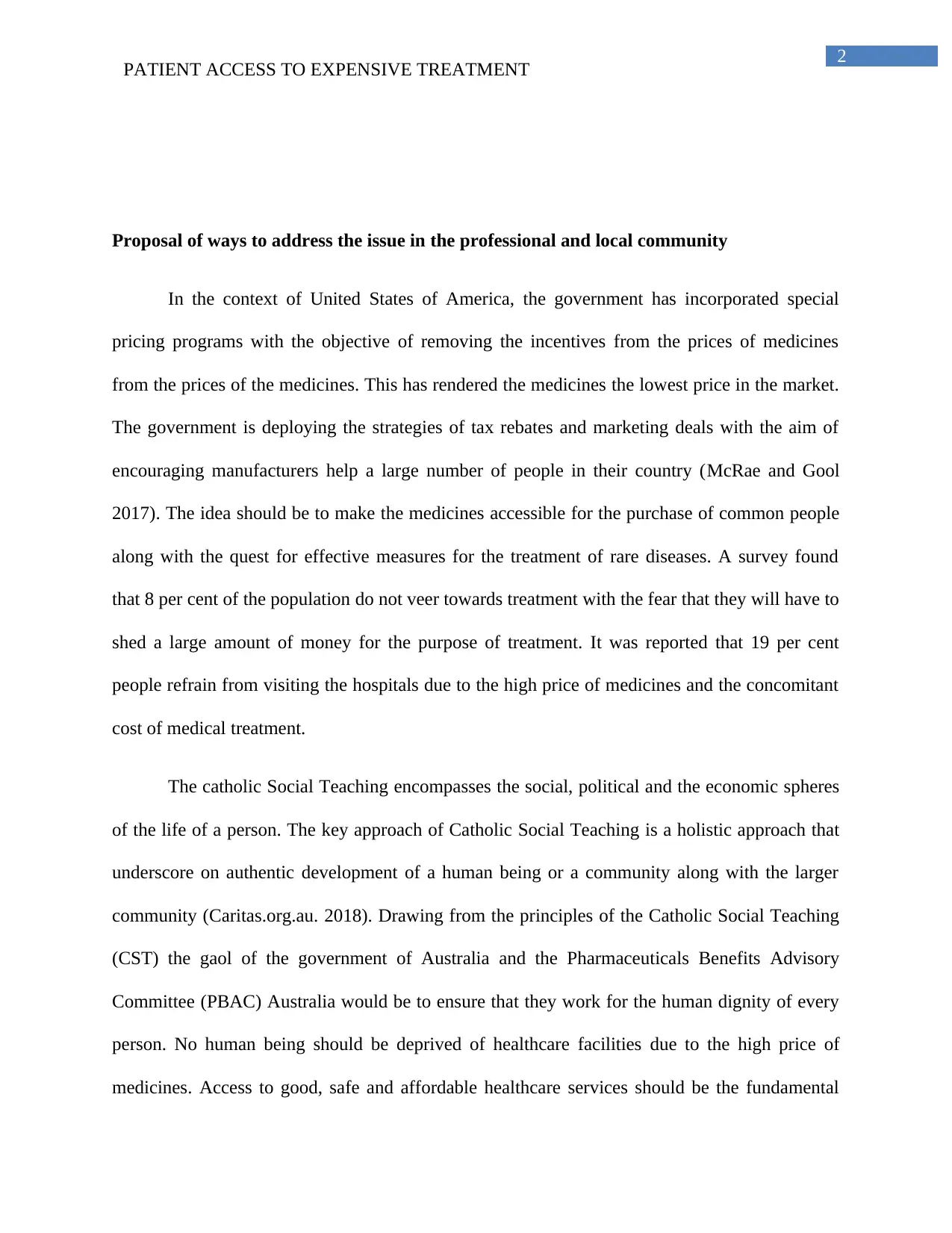
2
PATIENT ACCESS TO EXPENSIVE TREATMENT
Proposal of ways to address the issue in the professional and local community
In the context of United States of America, the government has incorporated special
pricing programs with the objective of removing the incentives from the prices of medicines
from the prices of the medicines. This has rendered the medicines the lowest price in the market.
The government is deploying the strategies of tax rebates and marketing deals with the aim of
encouraging manufacturers help a large number of people in their country (McRae and Gool
2017). The idea should be to make the medicines accessible for the purchase of common people
along with the quest for effective measures for the treatment of rare diseases. A survey found
that 8 per cent of the population do not veer towards treatment with the fear that they will have to
shed a large amount of money for the purpose of treatment. It was reported that 19 per cent
people refrain from visiting the hospitals due to the high price of medicines and the concomitant
cost of medical treatment.
The catholic Social Teaching encompasses the social, political and the economic spheres
of the life of a person. The key approach of Catholic Social Teaching is a holistic approach that
underscore on authentic development of a human being or a community along with the larger
community (Caritas.org.au. 2018). Drawing from the principles of the Catholic Social Teaching
(CST) the gaol of the government of Australia and the Pharmaceuticals Benefits Advisory
Committee (PBAC) Australia would be to ensure that they work for the human dignity of every
person. No human being should be deprived of healthcare facilities due to the high price of
medicines. Access to good, safe and affordable healthcare services should be the fundamental
PATIENT ACCESS TO EXPENSIVE TREATMENT
Proposal of ways to address the issue in the professional and local community
In the context of United States of America, the government has incorporated special
pricing programs with the objective of removing the incentives from the prices of medicines
from the prices of the medicines. This has rendered the medicines the lowest price in the market.
The government is deploying the strategies of tax rebates and marketing deals with the aim of
encouraging manufacturers help a large number of people in their country (McRae and Gool
2017). The idea should be to make the medicines accessible for the purchase of common people
along with the quest for effective measures for the treatment of rare diseases. A survey found
that 8 per cent of the population do not veer towards treatment with the fear that they will have to
shed a large amount of money for the purpose of treatment. It was reported that 19 per cent
people refrain from visiting the hospitals due to the high price of medicines and the concomitant
cost of medical treatment.
The catholic Social Teaching encompasses the social, political and the economic spheres
of the life of a person. The key approach of Catholic Social Teaching is a holistic approach that
underscore on authentic development of a human being or a community along with the larger
community (Caritas.org.au. 2018). Drawing from the principles of the Catholic Social Teaching
(CST) the gaol of the government of Australia and the Pharmaceuticals Benefits Advisory
Committee (PBAC) Australia would be to ensure that they work for the human dignity of every
person. No human being should be deprived of healthcare facilities due to the high price of
medicines. Access to good, safe and affordable healthcare services should be the fundamental
⊘ This is a preview!⊘
Do you want full access?
Subscribe today to unlock all pages.

Trusted by 1+ million students worldwide
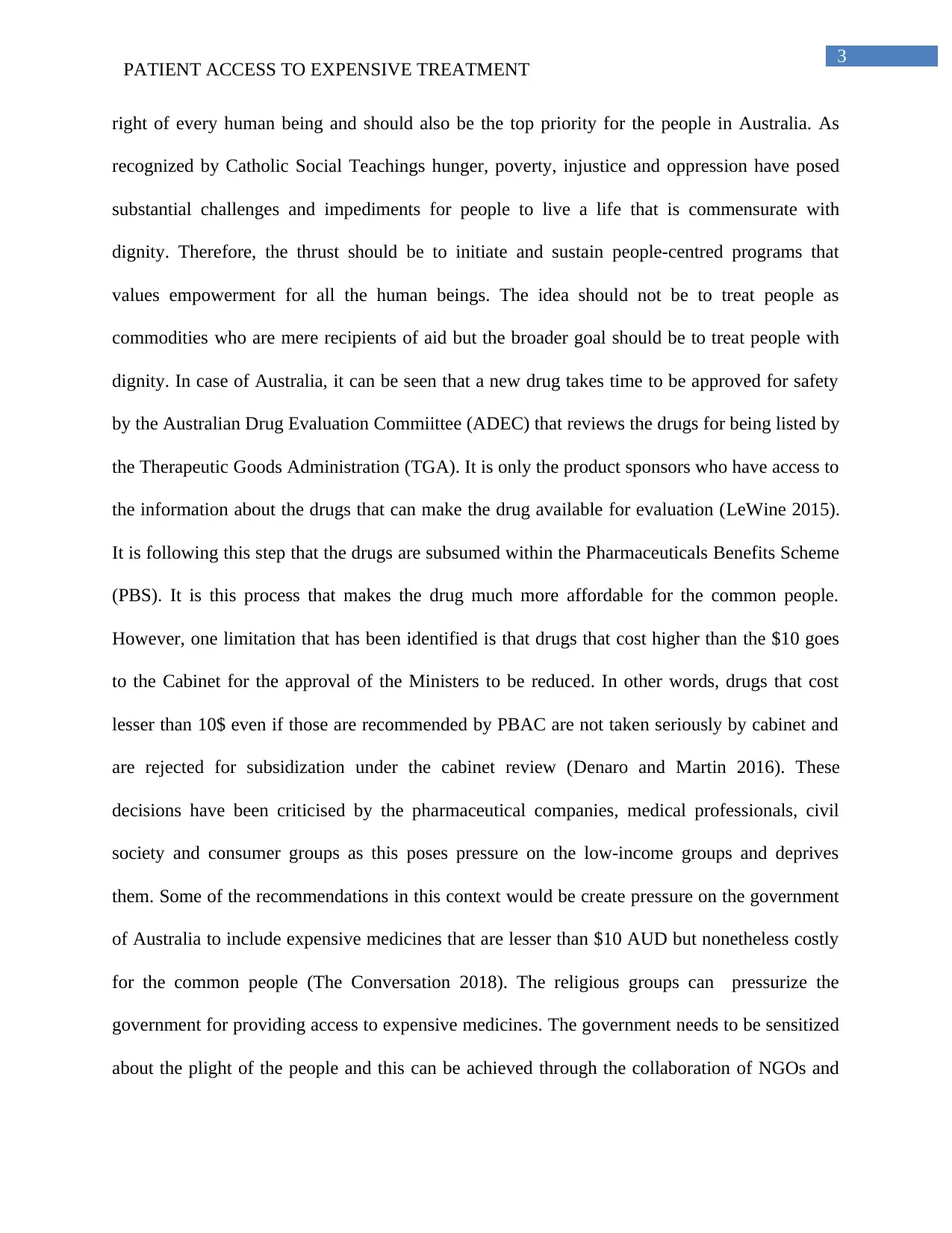
3
PATIENT ACCESS TO EXPENSIVE TREATMENT
right of every human being and should also be the top priority for the people in Australia. As
recognized by Catholic Social Teachings hunger, poverty, injustice and oppression have posed
substantial challenges and impediments for people to live a life that is commensurate with
dignity. Therefore, the thrust should be to initiate and sustain people-centred programs that
values empowerment for all the human beings. The idea should not be to treat people as
commodities who are mere recipients of aid but the broader goal should be to treat people with
dignity. In case of Australia, it can be seen that a new drug takes time to be approved for safety
by the Australian Drug Evaluation Commiittee (ADEC) that reviews the drugs for being listed by
the Therapeutic Goods Administration (TGA). It is only the product sponsors who have access to
the information about the drugs that can make the drug available for evaluation (LeWine 2015).
It is following this step that the drugs are subsumed within the Pharmaceuticals Benefits Scheme
(PBS). It is this process that makes the drug much more affordable for the common people.
However, one limitation that has been identified is that drugs that cost higher than the $10 goes
to the Cabinet for the approval of the Ministers to be reduced. In other words, drugs that cost
lesser than 10$ even if those are recommended by PBAC are not taken seriously by cabinet and
are rejected for subsidization under the cabinet review (Denaro and Martin 2016). These
decisions have been criticised by the pharmaceutical companies, medical professionals, civil
society and consumer groups as this poses pressure on the low-income groups and deprives
them. Some of the recommendations in this context would be create pressure on the government
of Australia to include expensive medicines that are lesser than $10 AUD but nonetheless costly
for the common people (The Conversation 2018). The religious groups can pressurize the
government for providing access to expensive medicines. The government needs to be sensitized
about the plight of the people and this can be achieved through the collaboration of NGOs and
PATIENT ACCESS TO EXPENSIVE TREATMENT
right of every human being and should also be the top priority for the people in Australia. As
recognized by Catholic Social Teachings hunger, poverty, injustice and oppression have posed
substantial challenges and impediments for people to live a life that is commensurate with
dignity. Therefore, the thrust should be to initiate and sustain people-centred programs that
values empowerment for all the human beings. The idea should not be to treat people as
commodities who are mere recipients of aid but the broader goal should be to treat people with
dignity. In case of Australia, it can be seen that a new drug takes time to be approved for safety
by the Australian Drug Evaluation Commiittee (ADEC) that reviews the drugs for being listed by
the Therapeutic Goods Administration (TGA). It is only the product sponsors who have access to
the information about the drugs that can make the drug available for evaluation (LeWine 2015).
It is following this step that the drugs are subsumed within the Pharmaceuticals Benefits Scheme
(PBS). It is this process that makes the drug much more affordable for the common people.
However, one limitation that has been identified is that drugs that cost higher than the $10 goes
to the Cabinet for the approval of the Ministers to be reduced. In other words, drugs that cost
lesser than 10$ even if those are recommended by PBAC are not taken seriously by cabinet and
are rejected for subsidization under the cabinet review (Denaro and Martin 2016). These
decisions have been criticised by the pharmaceutical companies, medical professionals, civil
society and consumer groups as this poses pressure on the low-income groups and deprives
them. Some of the recommendations in this context would be create pressure on the government
of Australia to include expensive medicines that are lesser than $10 AUD but nonetheless costly
for the common people (The Conversation 2018). The religious groups can pressurize the
government for providing access to expensive medicines. The government needs to be sensitized
about the plight of the people and this can be achieved through the collaboration of NGOs and
Paraphrase This Document
Need a fresh take? Get an instant paraphrase of this document with our AI Paraphraser

4
PATIENT ACCESS TO EXPENSIVE TREATMENT
civil society groups. The government should be presented with data on the plight of the common
Australians due to their inability to access to subsidized healthcare and as a result of which there
is a denial of the basic right of health (Vitry, Mintzes and Lipworth 2016). Academicians
working on the health, medicine and community health can come up with project by involving
students for engaging in a longitudinal research in which the objective would be to collect
information on the population who do not have access to subsidized medicines and the list of
medicines that are out of reach of the people. The notion behind conducting a longitudinal
research would be to go back to the same community and assessment of the impact of the
availability of subsidized medicines in the PBS listing. The data collected from this would
provide a deeper insight about the condition of inaccessible healthcare in the lives of Australians
and secondly it would enable the government to adopt strategies in that order. Religious groups
in Australia can step forward and use the funding received by them to provide these medicines at
the rate of fair price shops to the marginalized sections of the society. In the year 2010, the
Australian government along with the local pharmaceutical industry conceded to create a
Managed Entry Systems (MES). Another program would be to discuss with the hospitals,
nursing home and the healthcare organizations to distribute expensive medicines at a reasonable
cost (Wonder, Backhouse, and Sullivan 2012). People of Australia need to offer resistance as
they are paying a hefty amount of tax for these high-priced medicines and exhort the government
to create a sustainable public health system that is people-oriented and community0centred rather
than benefitting only a section of the society.
PATIENT ACCESS TO EXPENSIVE TREATMENT
civil society groups. The government should be presented with data on the plight of the common
Australians due to their inability to access to subsidized healthcare and as a result of which there
is a denial of the basic right of health (Vitry, Mintzes and Lipworth 2016). Academicians
working on the health, medicine and community health can come up with project by involving
students for engaging in a longitudinal research in which the objective would be to collect
information on the population who do not have access to subsidized medicines and the list of
medicines that are out of reach of the people. The notion behind conducting a longitudinal
research would be to go back to the same community and assessment of the impact of the
availability of subsidized medicines in the PBS listing. The data collected from this would
provide a deeper insight about the condition of inaccessible healthcare in the lives of Australians
and secondly it would enable the government to adopt strategies in that order. Religious groups
in Australia can step forward and use the funding received by them to provide these medicines at
the rate of fair price shops to the marginalized sections of the society. In the year 2010, the
Australian government along with the local pharmaceutical industry conceded to create a
Managed Entry Systems (MES). Another program would be to discuss with the hospitals,
nursing home and the healthcare organizations to distribute expensive medicines at a reasonable
cost (Wonder, Backhouse, and Sullivan 2012). People of Australia need to offer resistance as
they are paying a hefty amount of tax for these high-priced medicines and exhort the government
to create a sustainable public health system that is people-oriented and community0centred rather
than benefitting only a section of the society.
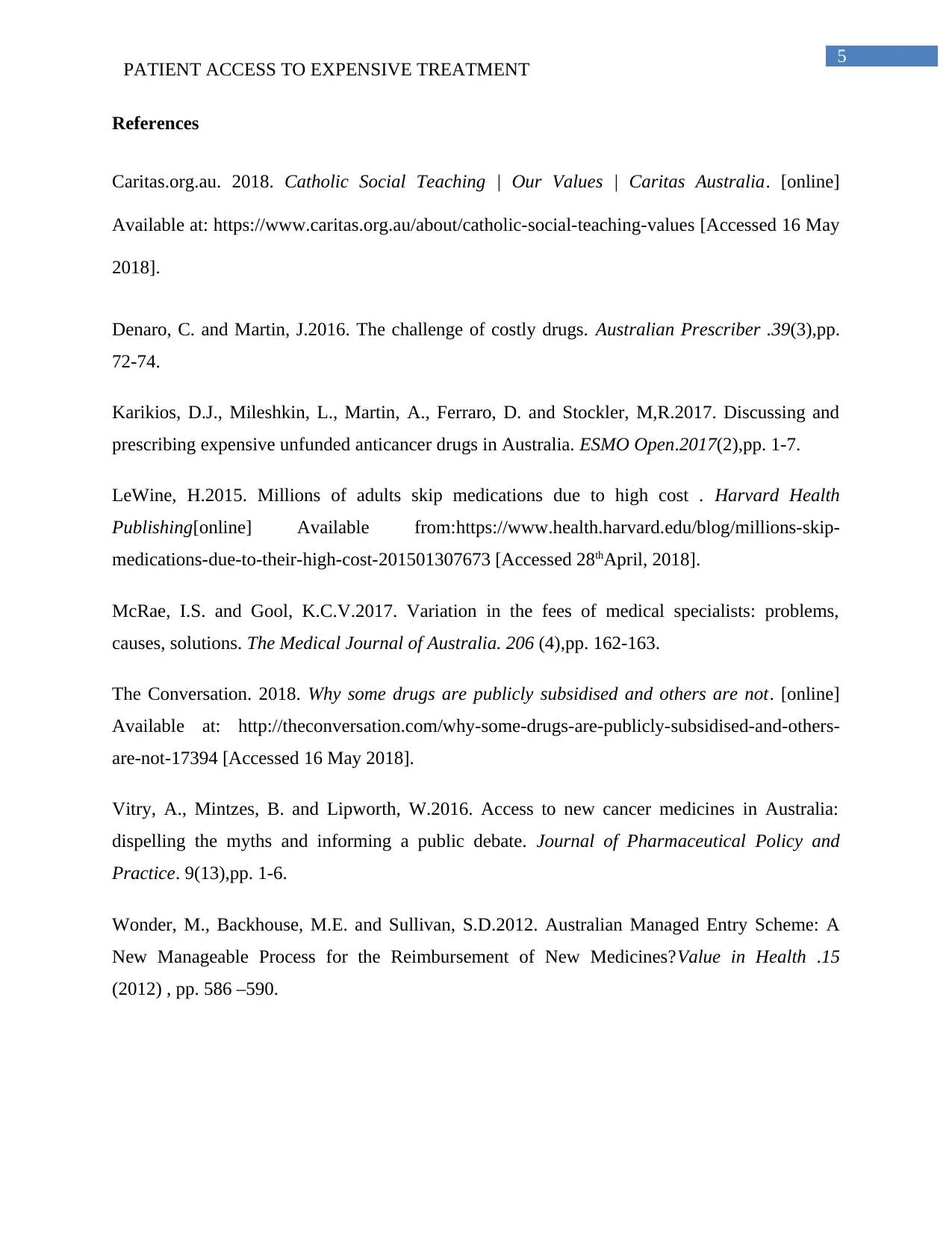
5
PATIENT ACCESS TO EXPENSIVE TREATMENT
References
Caritas.org.au. 2018. Catholic Social Teaching | Our Values | Caritas Australia. [online]
Available at: https://www.caritas.org.au/about/catholic-social-teaching-values [Accessed 16 May
2018].
Denaro, C. and Martin, J.2016. The challenge of costly drugs. Australian Prescriber .39(3),pp.
72-74.
Karikios, D.J., Mileshkin, L., Martin, A., Ferraro, D. and Stockler, M,R.2017. Discussing and
prescribing expensive unfunded anticancer drugs in Australia. ESMO Open.2017(2),pp. 1-7.
LeWine, H.2015. Millions of adults skip medications due to high cost . Harvard Health
Publishing[online] Available from:https://www.health.harvard.edu/blog/millions-skip-
medications-due-to-their-high-cost-201501307673 [Accessed 28thApril, 2018].
McRae, I.S. and Gool, K.C.V.2017. Variation in the fees of medical specialists: problems,
causes, solutions. The Medical Journal of Australia. 206 (4),pp. 162-163.
The Conversation. 2018. Why some drugs are publicly subsidised and others are not. [online]
Available at: http://theconversation.com/why-some-drugs-are-publicly-subsidised-and-others-
are-not-17394 [Accessed 16 May 2018].
Vitry, A., Mintzes, B. and Lipworth, W.2016. Access to new cancer medicines in Australia:
dispelling the myths and informing a public debate. Journal of Pharmaceutical Policy and
Practice. 9(13),pp. 1-6.
Wonder, M., Backhouse, M.E. and Sullivan, S.D.2012. Australian Managed Entry Scheme: A
New Manageable Process for the Reimbursement of New Medicines?Value in Health .15
(2012) , pp. 586 –590.
PATIENT ACCESS TO EXPENSIVE TREATMENT
References
Caritas.org.au. 2018. Catholic Social Teaching | Our Values | Caritas Australia. [online]
Available at: https://www.caritas.org.au/about/catholic-social-teaching-values [Accessed 16 May
2018].
Denaro, C. and Martin, J.2016. The challenge of costly drugs. Australian Prescriber .39(3),pp.
72-74.
Karikios, D.J., Mileshkin, L., Martin, A., Ferraro, D. and Stockler, M,R.2017. Discussing and
prescribing expensive unfunded anticancer drugs in Australia. ESMO Open.2017(2),pp. 1-7.
LeWine, H.2015. Millions of adults skip medications due to high cost . Harvard Health
Publishing[online] Available from:https://www.health.harvard.edu/blog/millions-skip-
medications-due-to-their-high-cost-201501307673 [Accessed 28thApril, 2018].
McRae, I.S. and Gool, K.C.V.2017. Variation in the fees of medical specialists: problems,
causes, solutions. The Medical Journal of Australia. 206 (4),pp. 162-163.
The Conversation. 2018. Why some drugs are publicly subsidised and others are not. [online]
Available at: http://theconversation.com/why-some-drugs-are-publicly-subsidised-and-others-
are-not-17394 [Accessed 16 May 2018].
Vitry, A., Mintzes, B. and Lipworth, W.2016. Access to new cancer medicines in Australia:
dispelling the myths and informing a public debate. Journal of Pharmaceutical Policy and
Practice. 9(13),pp. 1-6.
Wonder, M., Backhouse, M.E. and Sullivan, S.D.2012. Australian Managed Entry Scheme: A
New Manageable Process for the Reimbursement of New Medicines?Value in Health .15
(2012) , pp. 586 –590.
⊘ This is a preview!⊘
Do you want full access?
Subscribe today to unlock all pages.

Trusted by 1+ million students worldwide
1 out of 6
Related Documents
Your All-in-One AI-Powered Toolkit for Academic Success.
+13062052269
info@desklib.com
Available 24*7 on WhatsApp / Email
![[object Object]](/_next/static/media/star-bottom.7253800d.svg)
Unlock your academic potential
Copyright © 2020–2025 A2Z Services. All Rights Reserved. Developed and managed by ZUCOL.





